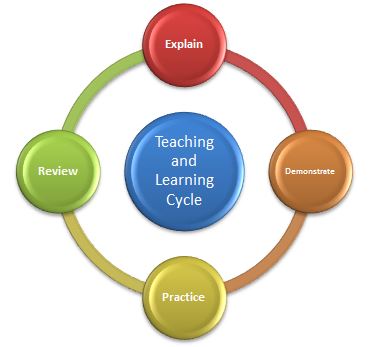Teaching and Learning Cycle
The Teaching and Learning Cycle is a remarkably simple way of thinking about the instruction and learning steps a player and team progress through on their way to developing knowledge, skills and ultimately competence. The Teaching and Learning Cycle is not overly complicated by for many coaches this simple progression will be all that is needed in framing what and how to instruct during their training sessions and games.
The Teaching and Learning Cycle consists of four steps within the process. These are:
- Explain
- Demonstrate
- Practice
- Review

To Explain is to provide the reasoning behind why the activity is important to the development of the player and the team. It is when the importance of doing the small things right can be linked to making big things happen.
Demonstration is when the activity is introduced to the player or team by the coach. In this stage the movement is very controlled and often undertaken at a slower pace with each element highlighted and performed with the upmost care to provide an image of “perfect practice” of the technique. This demonstration is of course accompanied by specific verbal cues relevant to the sport.
Practice is the opportunity for players to perform the activity. This maybe as a group or individually. Feedback in this situation is not delivered to the group but should be on an individual basis to ensure the minimum number of repetitions can be achieved for optimum player development. If a coach is to stop and to talk to the group too frequently, they will rob the players of their chance to truly learn from the experience to a sufficient level.
Finally the Evaluation stage of the Teaching and Learning Cycle is about providing feedback not in specific terms to the individual (unless in an individual sport), but rather to the team as a collective. Focusing on the issues happening most readily to the group. The individual feedback opportunity happened in the practice stage.
The Teaching and Learning Cycle outlines most importantly for coaches some simple steps in the way information should be communicated to players to achieve the most succinct and efficient results. Missing even one of the steps within the Teaching and Learning Cycle will result in slower up take of the knowledge or skill trying to be instilled in the player. Taking the time to ensure the planning of each training session will help, but where the Teaching and Learning Cycle comes into its own is when we look at the repercussions of this process within the delivery of information concerning each and every drill or activity.
For example during the presentation of a new drill a coach must take the time to explain what is desired. A coach should start by linking the drill or activity to what the team’s goals and objectives are (Explain). Linking the breakdown or fundamental technical skill to the bigger picture helps add value to the activity, which helps with motivation and concentration of the individuals as to why this is important.
Then define each step in the technique or each phase of the activity through doing (Demonstrate). This may mean the coach himself or herself performing the technical skill or this may be undertaken with a small group with the rest of the team observing.
The Practice stage in the Teaching and Learning Cycle is fulfilled by now allowing the players to perform the drill or activity. This stage however is not void of input by the coach or the assistants. A coach must be very active in “coaching on the run” to continuously provide feedback, direction and refinement to the performance.
The final stage of Evaluation comes in the process of bring the players together to discuss the common and most significant issues identified with the majority of the groups performances. This does not mean every flaw is to be highlighted, the refinement of the performances come not from the one off performance, but constant and ongoing repetition over multiple occasions.
The Teaching and Learning Cycle is a very simple and a useful tool in helping coaches picture how their message needs to be delivered to the player. By ensuring each of these steps is covered within a drill or activity the coach will be providing the best possible opportunity for their players development and constant improvement.



Leave a Reply